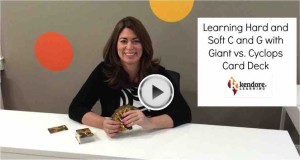Mastering hard and soft c and g rules is an advanced skill that yields significant rewards. Beginning readers frequently encounter hard c and g sounds as they learn single syllable words (for example: cat, cloud, go, and glow). However, soft c and g are often found in Greek and Latin roots so they tend to appear in more complex, multi-syllabic words. Understanding how to decode c and g enables students to read very complex words (for example: biological and circumspect).
Hard and Soft C and G Rules
When c is in front of an i, y, or e, it is soft and says /s/. For example: city, cycle, and race.
When c is in front of any other letter, it is hard and says /k/. For example: camera, car, and cone.
When g is in front of an i, y, or e, it is soft and says /j/. For example: giant, gypsy, and gem.
When g is in front of any other letter, it says /g/. For example: go, gave, and gravel.
There are some common sight words that don’t follow the rules (for example: girl and gift). This is why we teach hard and soft c and g rules to older students, who already have good mastery over basic sight words and phonics concepts. These students can handle the additional layer of hard and soft c and g rules.
Giant vs. Cyclops: Hard and Soft C and G Games
Our Giant vs. Cyclops card deck gives students a fun way to practice applying hard and soft c and g rules. The game comes complete with instructions for playing six games of varying difficulty. To ensure mastery, the deck contains real and nonsense words (nonsense words force players to decode rather than memorize). Click below for a video demonstration of two fun Giant vs. Cyclops card games.


